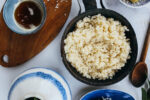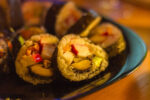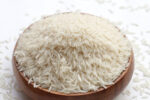Basmati rice is a unique, aromatic long-grain rice primarily grown in the Indian subcontinent, including India and Pakistan. Known for its nutty flavor and distinct fragrance, it is a popular choice in Indian, Middle Eastern, and Persian cuisines. The word “basmati” translates to “fragrant” in Hindi, reflecting its pleasant aroma.
Characteristics of Basmati Rice
Basmati rice is distinguishable by several key traits:
- Long, Slender Grains: Basmati grains are longer and thinner compared to other types of rice. They elongate significantly during cooking, often more than doubling in length.
- Distinct Aroma: The aroma of basmati comes from the presence of a chemical compound called 2-acetyl-1-pyrroline, which gives the rice its signature smell, often described as “popcorn-like.”
- Light and Fluffy Texture: Unlike many other rice varieties, basmati rice tends to remain separate and non-sticky after cooking, resulting in a fluffy texture ideal for pilafs and biryanis.
Types of Basmati Rice
- Traditional Basmati: This variety is harvested from fields in India and Pakistan. It offers a more pronounced fragrance and flavor compared to hybrid varieties.
- Aged Basmati: Basmati rice is often aged for a period (from several months to years) to enhance its aroma and reduce moisture content. Aged basmati is prized for its robust flavor and the elongation of grains during cooking.
- Brown Basmati: This is the whole-grain version of basmati rice, where the outer bran layer is retained. Brown basmati rice is more nutritious than white basmati, containing higher levels of fiber, vitamins, and minerals.
Nutritional Profile of Basmati Rice
White basmati rice is a source of carbohydrates, with lower fiber content than whole grains like brown rice, but it still offers several nutritional benefits. Here is the approximate nutritional content for 1 cup of cooked white basmati rice:
- Calories: 200-210
- Carbohydrates: 45g
- Protein: 4g
- Fat: 0g
- Fiber: 0.6g
Brown basmati rice contains more fiber (approximately 3.5g per cup), making it a healthier alternative for those seeking more whole grains in their diet.
Culinary Uses of Basmati Rice
Basmati rice is a staple in many South Asian and Middle Eastern dishes. Its versatility makes it suitable for a variety of recipes, such as:
- Biryani: A popular layered rice dish made with meat (or vegetables) and a variety of spices.
- Pilaf (Pulao): Basmati is often used to make pilaf, a rice dish cooked in seasoned broth, often with vegetables, nuts, or dried fruit.
- Side Dish: Basmati rice is frequently served as a side dish with curries, grilled meats, or vegetables.
- Kheer (Rice Pudding): A popular Indian dessert made by boiling basmati rice with milk, sugar, and spices like cardamom.
Preservation of Basmati Rice
Proper storage of basmati rice, both uncooked and cooked, is essential to maintain its freshness, aroma, and texture. Below are some key methods for preserving basmati rice:
Storing Uncooked Basmati Rice
Basmati rice, like other long-grain white rice varieties, can have a long shelf life if stored correctly. Here are some tips:
- Airtight Containers: Store uncooked basmati rice in a cool, dry place, preferably in an airtight container to prevent moisture absorption and protect against pests. Under these conditions, basmati rice can last for up to 4-5 years.
- Vacuum Sealing: For longer-term storage, vacuum-sealing basmati rice can further protect it from moisture and pests, extending its shelf life beyond 5 years.
- Freezing: Uncooked basmati rice can be frozen in sealed freezer bags or containers. Freezing helps preserve its aroma and freshness, especially in humid environments.
Preserving Cooked Basmati Rice in the Fridge
Cooked basmati rice, like any cooked rice, must be stored properly to avoid bacterial growth:
- Cool Rice Quickly: Spread the cooked rice on a shallow tray or dish to cool it quickly. Allow it to cool to room temperature within an hour.
- Refrigerate Immediately: Transfer the cooled rice into an airtight container and refrigerate. Cooked basmati rice will stay fresh in the refrigerator for up to 4-6 days.
- Label and Date: Label the container with the date to track how long the rice has been stored.
Reheating Cooked Basmati Rice
To safely reheat basmati rice and maintain its fluffy texture:
- Microwave: Add a few tablespoons of water to the rice, cover the container with a microwave-safe lid, and heat on high until steaming (ensure it reaches 165°F (74°C)).
- Stovetop: Place the rice in a saucepan with a splash of water, cover, and heat on medium until the rice is hot throughout.
Other Methods of Preserving Cooked Basmati Rice
- Freezing Cooked Basmati Rice: Cooked basmati rice can be frozen for up to 6 months. Portion the rice into freezer bags or containers, removing as much air as possible to prevent freezer burn. When reheating, use a microwave or stovetop to thaw the rice, ensuring it reaches a safe temperature.
- Vacuum Sealing Cooked Rice: Vacuum-sealing cooked rice before freezing can further extend its freshness, helping maintain its texture and moisture content.
Health Considerations
Basmati rice has a low to medium glycemic index (GI), typically around 50-58, which is lower than other white rice varieties. This means that it causes a slower increase in blood sugar levels compared to regular white rice, making it a preferred choice for individuals with diabetes or those monitoring their blood sugar levels.
Basmati rice, particularly its brown version, offers more fiber and micronutrients, such as magnesium, phosphorus, and zinc. For a more balanced diet, swapping white basmati rice for brown basmati may provide more nutritional benefits, including improved digestive health due to its higher fiber content.
Risks and Considerations in Basmati Rice Preservation
- Moisture Sensitivity: Basmati rice can absorb moisture from the environment, which can compromise its quality and cause spoilage. Keeping uncooked rice in an airtight container, especially in humid climates, is crucial for maintaining freshness.
- Bacterial Growth in Cooked Rice: Like all cooked rice, basmati rice is susceptible to bacterial contamination if left at room temperature for extended periods. It is essential to refrigerate or freeze rice promptly after cooking to prevent bacteria like Bacillus cereus from developing.
Conclusion
Basmati rice is celebrated for its distinctive aroma, long grains, and fluffy texture, making it a popular choice in a variety of international cuisines. With proper storage techniques, uncooked basmati rice can be preserved for years, while cooked rice, if refrigerated or frozen correctly, can maintain its freshness and flavor. Whether used in rich biryanis or simple side dishes, basmati rice remains a nutritious and flavorful staple in households around the world.





